Cambodia is home to a wide variety of birds and has become a popular destination for birdwatchers. In this country, one can find over 600 species of birds, many of which are endemic, making Cambodia a prime destination for bird enthusiasts.
With its rich biodiversity, Cambodia’s bird population has something to offer everyone, from the most experienced birdwatchers to the novice observers. From the majestic Great Hornbill to the tiny Pygmy Wren-Babbler, Cambodia’s bird species are sure to delight and surprise.
1. Giant Ibis
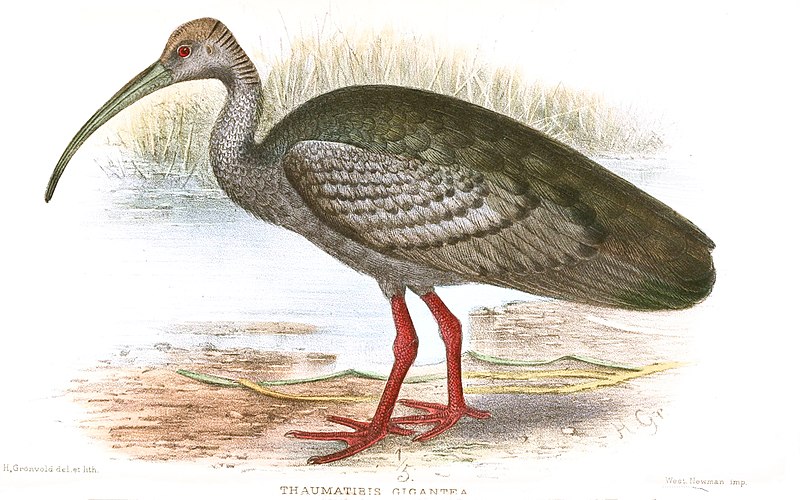
The Giant Ibis is a magnificent bird found in northern Cambodia, southern Laos and even Vietnam. It belongs to the Threskiornithidae family of wading birds and are the only species present in its monotypic genus – Thaumatibis.
These birds prefer lowland habitats such as marshes, swamps, wide rivers or flooded plains for their habitat.
Their diet comprises of small aquatic animals like fish, crabs and amphibians that they hunt with their long beaks while on land; insects make up for most of it when they take flight.
The giant ibises have faced tremendous threats from human activities like deforestation and hunting which puts them at risk of extinction; however conservation efforts are underway today to protect these beautiful creatures before it’s too late.Scientific classification:
| Kingdom | Animalia |
| Phylum | Chordata |
| Class | Aves |
| Order | Pelecaniformes |
| Family | Threskiornithidae |
| Genus | Thaumatibis Elliot, 1877[2] |
| Species | T. gigantea |
2. White-Shouldered Ibis
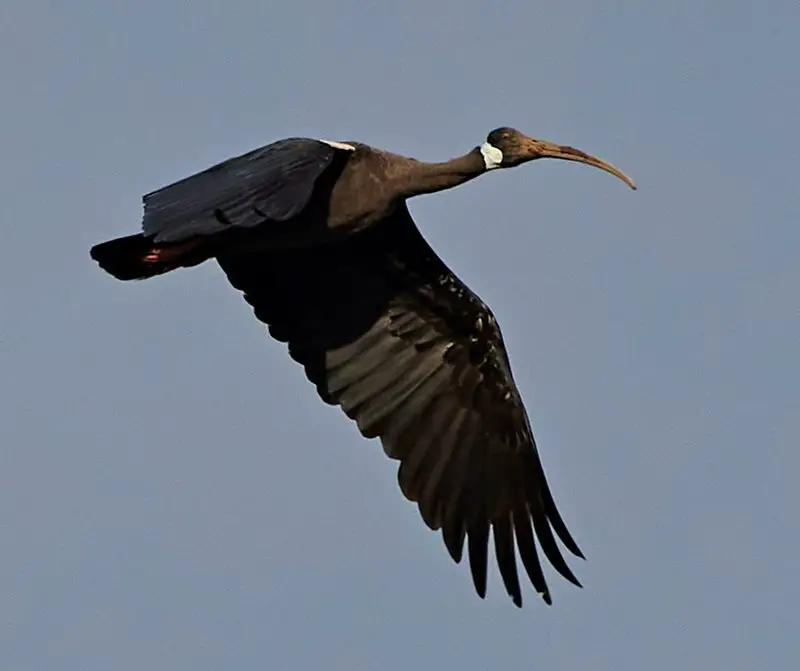
The white-shouldered ibis is a large species of bird found in small regions of Southeast Asia, and unfortunately it’s one of the most endangered birds on this part of the continent.
It was originally named Geronticus davisoni by Hume (1875) after his bird collector Willi.
This species has a distinct black bill with whitish facial skin patches surrounding its eyes and extending down to its throat.
While its back, wings and tail are greyish-brown with an iridescent sheen when viewed at certain angles.
However, their main feature that sets them apart from other birds is their white shoulder feathers which give rise to their name.
These magnificent creatures face many threats including human activities such as habitat destruction caused by agricultural expansion or logging for timber, making conservation efforts crucial for saving these unique birds from extinction.Scientific classification:
| Kingdom | Animalia |
| Phylum | Chordata |
| Class | Aves |
| Order | Pelecaniformes |
| Family | Threskiornithidae |
| Genus | Pseudibis |
| Species | P. davisoni |
3. Jacanas
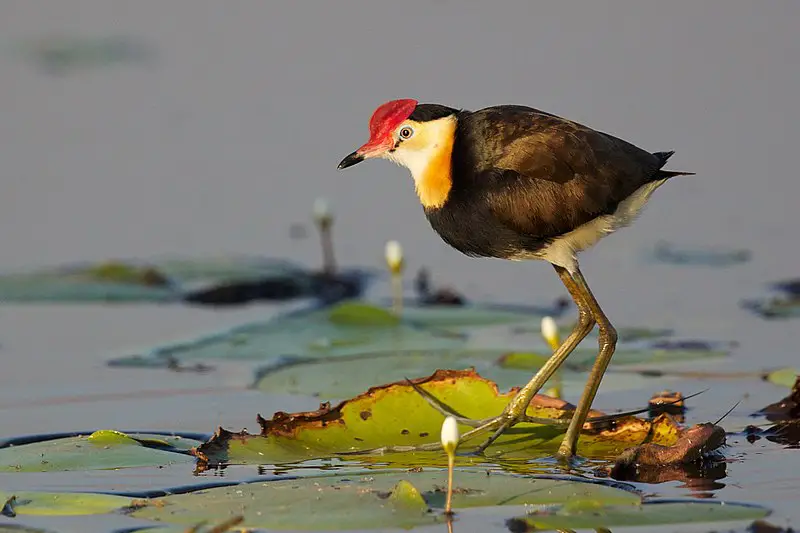
Jacanas are tropical waders belonging to the Jacanidae family. They have distinctive elongated toes and toenails which help them forage on floating or semi-emergent aquatic vegetation.
This adaptation gives them their nickname “Jesus birds” as they seem to be able to walk on water.
The female jacanas are also unique amongst bird species in that they take charge of nest building, incubation and caring for young while males perform courtship displays.
These unusual birds can be found throughout the world’s tropical regions where they inhabit wetlands such as swamps, marshes and shallow lakes with lily pads.
With a wide variety range due their special adaptations these beautiful creatures will surely continue living life at ease around our planet’s warmest waters.Scientific classification:
| Kingdom | Animalia |
| Phylum | Chordata |
| Class | Aves |
| Order | Charadriiformes |
| Suborder | Thinocori |
| Family | Jacanidae Stejneger, 1885 |
4. Eurylaimidae
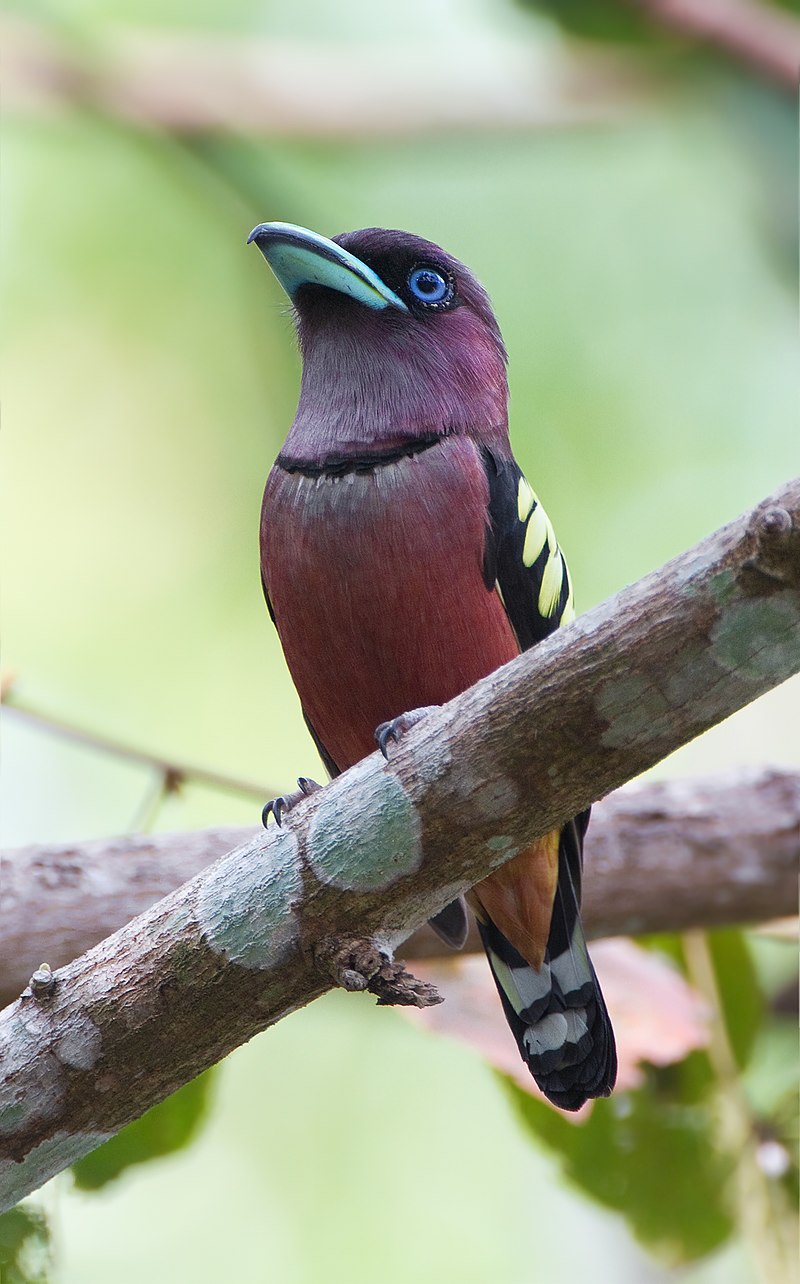
The Eurylaimidae family of birds is a diverse group, found in the eastern Himalayas all the way to Indonesia and Philippines.
They are suboscine passerines that have been known for their bright colours and broad heads.
Majority of these species live in tropical forests or wetlands, where they feed on small invertebrates like insects and worms.
Some specific species such as drongos use mimicry calls to communicate with other animals while most eurylaimids sing beautiful songs during mating season or territorial disputes.
In addition, many members of this family can actively hunt prey using aerial manoeuvres which make them interesting study subjects for ornithologists around the world.Scientific classification:
| Kingdom | Animalia |
| Phylum | Chordata |
| Class | Aves |
| Order | Passeriformes |
| Superfamily | Eurylaimoidea |
| Family | Eurylaimidae Lesson, 1831 |
5. Ciconiiformes
Ciconiiformes are large-sized, long-legged water birds found in a variety of habitats. These include marshes and wet meadows, as well as shallow lakes, rivers and streams.
They often forage on the ground or wade through shallow water to search for food such as small fish, frogs and aquatic insects. Ciconiiformes typically have long necks that enable them to reach into deeper waters when searching for prey beneath the surface.
Many species also possess webbed feet which help propel them through the water with ease while they’re hunting or migrating from one location to another. Some members of this group even use their wings like oars during flight.
Although most ciconiiformes feed mainly on fish and other aquatic animals they can also be opportunistic omnivores consuming any type of food available depending upon what is seasonally abundant at particular times throughout their lives.
6. Pelecaniformes
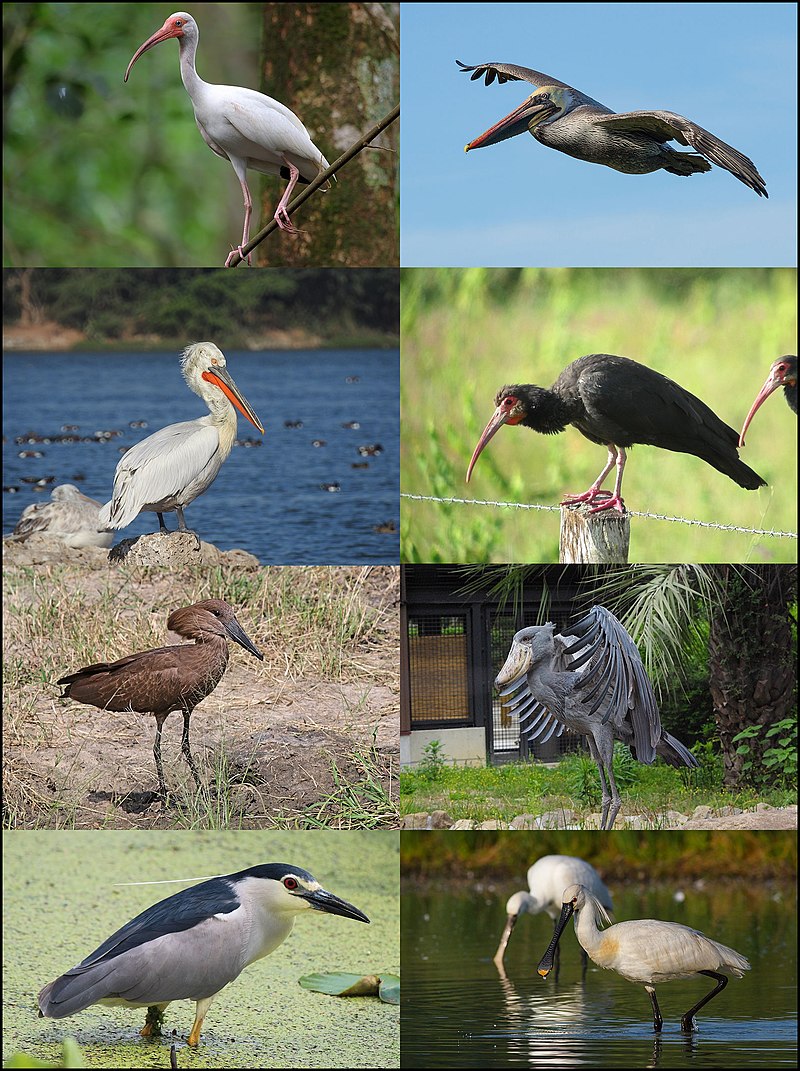
Pelecaniformes are a diverse order of waterbirds found all around the world. They vary in size, but most species are medium to large birds with webbed feet and a bare throat patch (gular patch).
Their nostrils have evolved into non-functional slits. Some examples include pelicans, gannets, cormorants and frigatebirds which can be found near coasts or on inland waters such as lakes or rivers.
Many Pelecaniforms fish for food by diving underwater from the air – some even swim underwater.
The diet of these birds consists mainly of small fishes although they may also eat mollusks, crustaceans and other aquatic creatures depending on their location.
All in all, Pelecaniformes make an important contribution to our planet’s biodiversity by keeping populations of fish under control while providing us with great views when we’re out exploring nature.Scientific classification:
| Kingdom | Animalia |
| Phylum | Chordata |
| Class | Aves |
| Clade | Aequornithes |
| Order | Pelecaniformes Sharpe, 1891 |
7. Coraciiformes
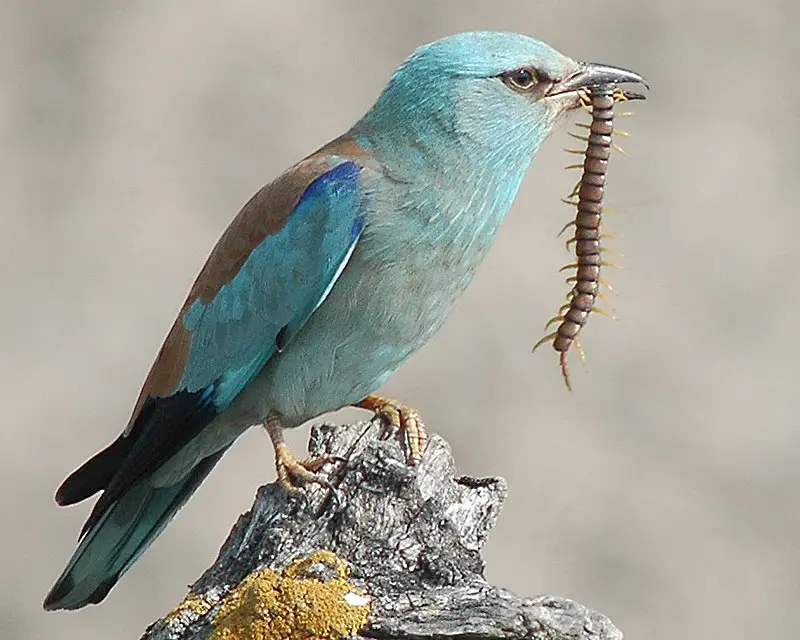
Coraciiformes birds are a group of beautiful and vibrant species, including kingfishers, bee-eaters, rollers, motmots and todies. They have syndactyly feet with three forward pointing toes (with their third and fourth fused at the base).
However in some kingfisher species one toe is absent. This order of bird has an interesting behavior known as ‘slamming’ which links them all together.
These amazing creatures can be seen across many parts of the world from forests to deserts.
Their colorful feathers make them stand out amongst other birds making sure they don’t go unnoticed.Scientific classification:
| Kingdom | Animalia |
| Phylum | Chordata |
| Class | Aves |
| Clade | Picodynastornithes |
| Order | Coraciiformes Forbes, 1884 |
8. Greater Adjutant
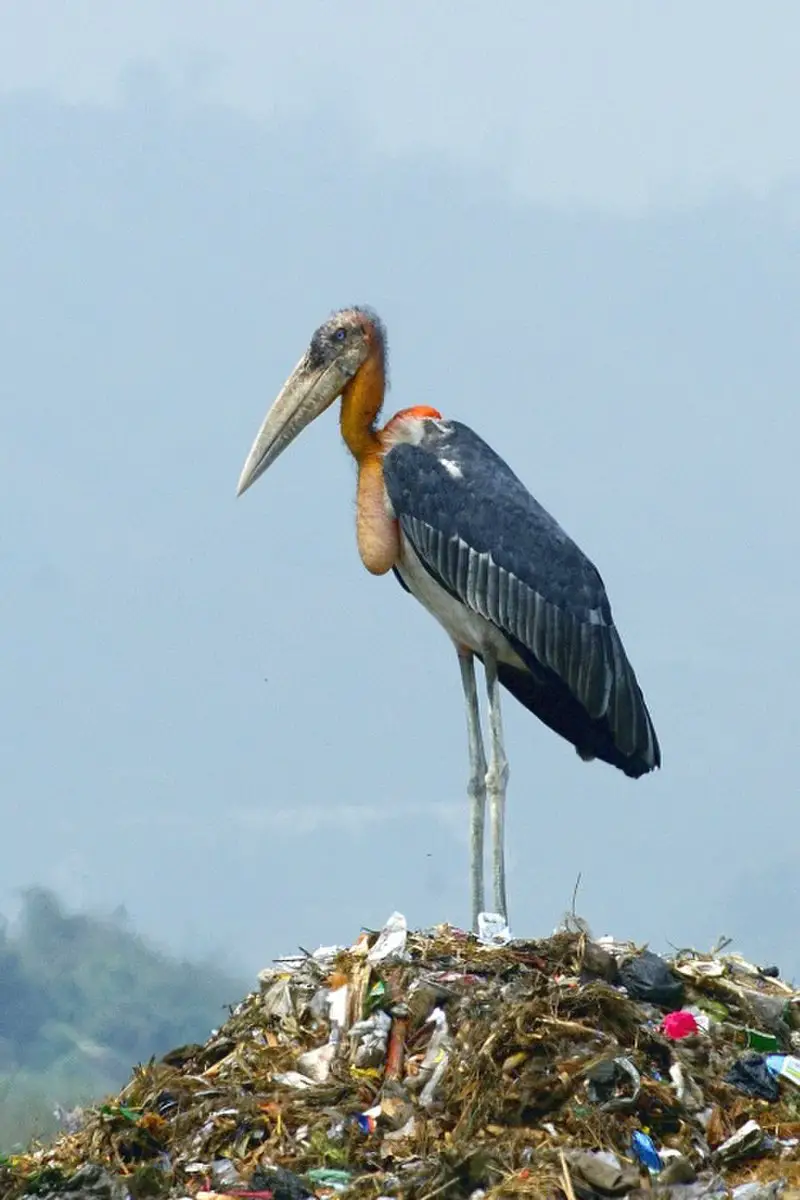
The Greater Adjutant is a majestic member of the stork family, Ciconiidae. It was once found in wide regions across southern and mainland Southeast Asia but now only three breeding populations remain – two in India with the largest colony being located in Assam and another smaller one on an island off Myanmar.
The bird has blackish-grey plumage which stands out against its white shoulder patches giving it a distinctive appearance.
Its large bill gives it an impressive look befitting its size as this species can reach up to 1 metre tall.
Despite their formidable presence, these birds are highly vulnerable due to their small population numbers making them critically endangered.
Conservation efforts such as habitat protection must continue if we are to ensure that future generations will get to admire this beautiful bird for many years yet to come.Scientific classification:
| Kingdom | Animalia |
| Phylum | Chordata |
| Class | Aves |
| Order | Ciconiiformes |
| Family | Ciconiidae |
| Genus | Leptoptilos |
| Species | L. dubius |
9. Black-Headed Woodpecker
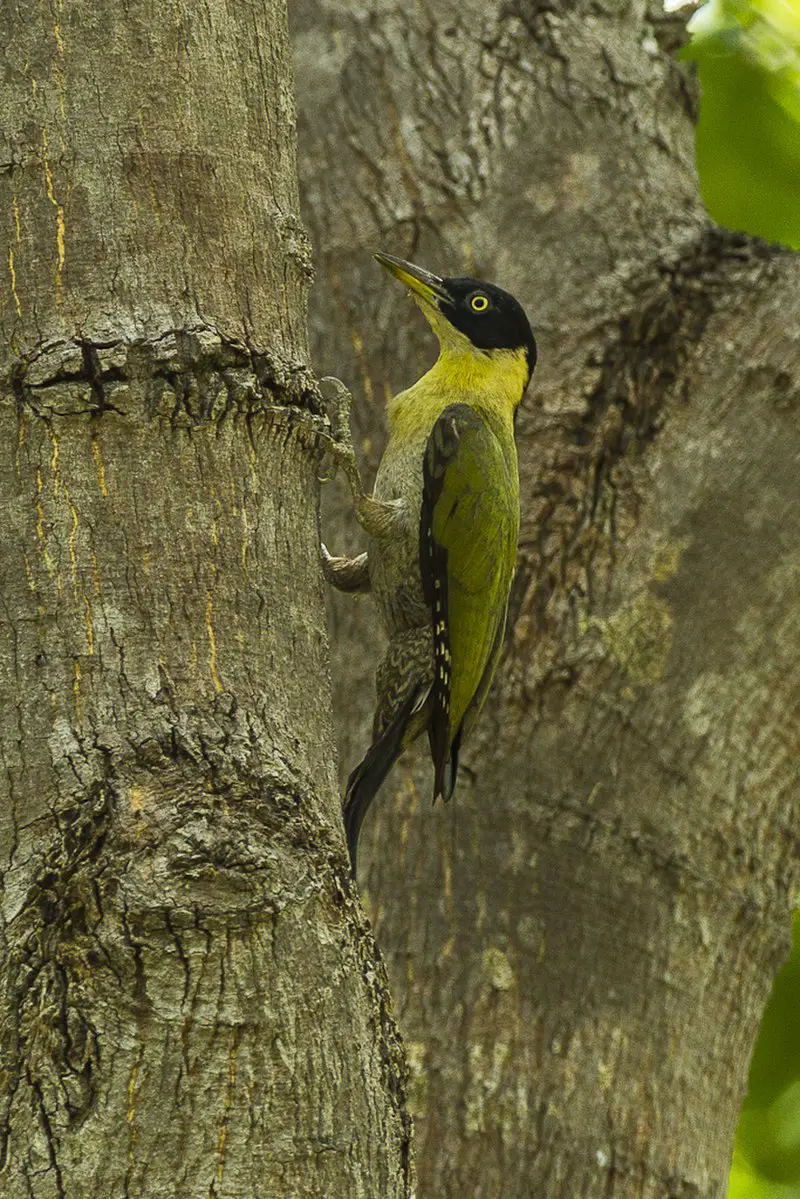
The Black-headed Woodpecker is a beautiful bird species found in Southeast Asia. It has striking plumage with black face, yellow throat and green wings, while its back and tail are red-brown or rufous.
The adult birds measure around 33 cm in length and weigh between 100 to 135 gm. They inhabit both deciduous as well as coniferous forests primarily located in Cambodia, Laos Myanmar, Thailand and Vietnam .
These woodpeckers feed on insects which they search for by probing at the base of tree trunks using their strong beaks.They also eat fruits from trees suchas figs , dates etc alongwith nuts that have been buried by squirrels.
Though not endangered yet these birds need our protection so that future generations can continue to enjoy them too .Scientific classification:
| Kingdom | Animalia |
| Phylum | Chordata |
| Class | Aves |
| Order | Piciformes |
| Family | Picidae |
| Genus | Picus |
| Species | P. erythropygius |
10. White-Rumped Vulture
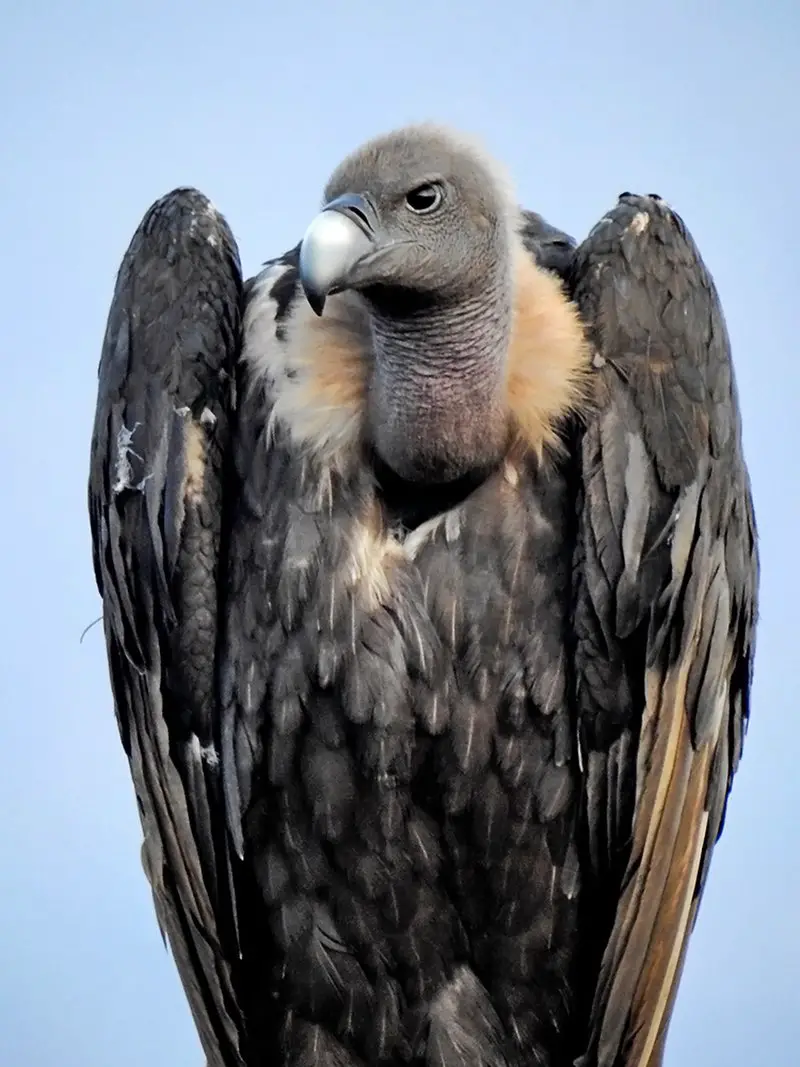
The white-rumped vulture is an Old World species found mainly in South and Southeast Asia. Sadly, it has been listed as Critically Endangered by the IUCN Red List since 2000 due to a severe decline in its population numbers.
The cause of this rapid drop is diclofenac poisoning which leads to kidney failure for these birds.
In the 1980s there were estimated to be several million individuals, but now their numbers have dropped drastically with some experts estimating them at fewer than 10 thousand breeding pairs left today.
Conservation efforts are underway across numerous countries to help save this unique species from extinction and raise awareness about the dangers posed by diclofenac pollution on wildlife populations around the world.Scientific classification:
| Kingdom | Animalia |
| Phylum | Chordata |
| Class | Aves |
| Order | Accipitriformes |
| Family | Accipitridae |
| Genus | Gyps |
| Species | G. bengalensis |
Also Featured In: Gujarati Birds, Birds that Live in Rajasthan
11. Spot-Billed Pelican
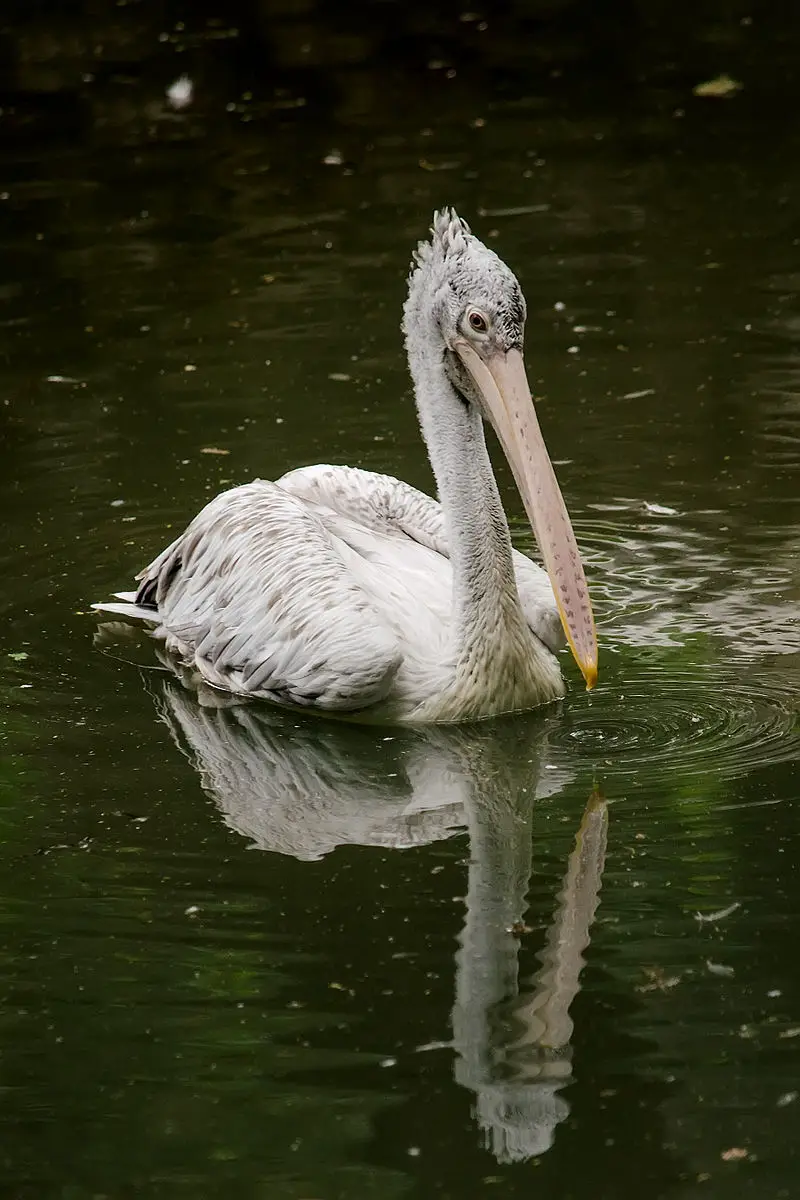
The Spot-billed Pelican is a species of the pelican family that lives in southern Asia, ranging from Iran to Indonesia. It prefers large inland and coastal waters like lakes.
These birds are quite small compared to other types of pelicans, making them difficult to identify from afar but their distinguishing feature is the spots on its bill which can be seen up close.
They feed mainly on fish by diving into water and scooping out prey with their long bills. During breeding season they build nests near bodies of water and lay two or three eggs per clutch.
The spot-billed pelican is an important part of local ecosystems as it helps keep populations of certain aquatic preys down while providing food for larger predators such as raptors and crocodiles.Scientific classification:
| Kingdom | Animalia |
| Phylum | Chordata |
| Class | Aves |
| Order | Pelecaniformes |
| Family | Pelecanidae |
| Genus | Pelecanus |
| Species | P. philippensis |
Also Featured In: Birds of Karnataka, Birds that Migrate to Sri Lankan
12. Painted Stork
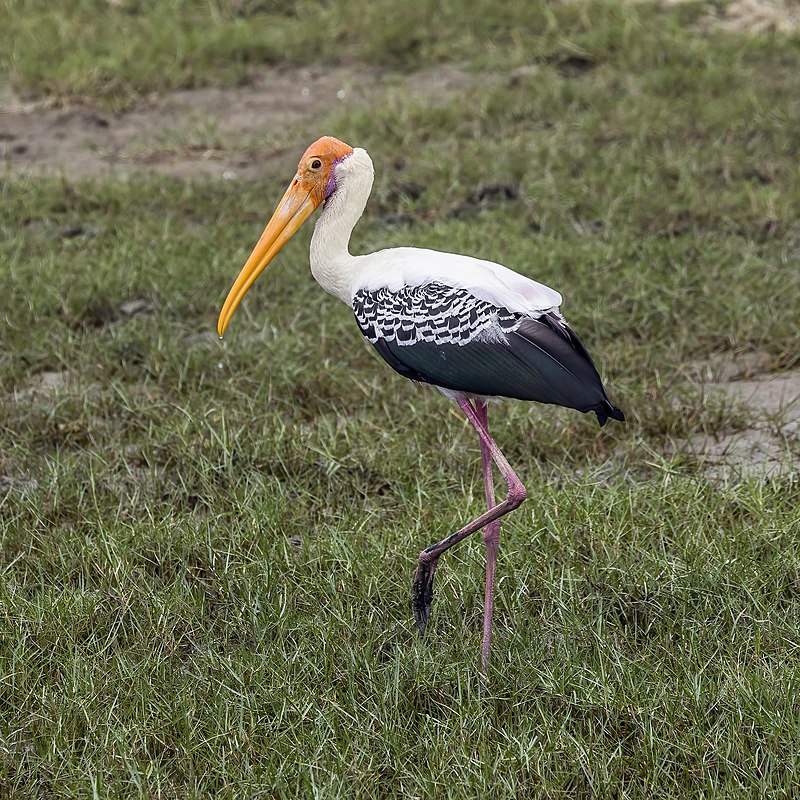
The Painted Stork is a large bird that belongs to the stork family. It has an impressive wingspan and can be found in tropical Asia, ranging from the Indian subcontinent all the way to Southeast Asia.
These birds are unique because of their pink tertial feathers, which gives them their name. They form flocks when they forage in shallow waters near rivers or lakes.
They dip their half-open beaks into water looking for food such as fish, frogs and other small aquatic creatures.
A distinctive feature of these birds is that during breeding season both males and females have red eyes with yellow rings around them.
This species also displays amazing cooperative behaviour when nesting; young storks help build nests by bringing material back to older ones who weave it together forming huge colonies on trees close to wetlands.Scientific classification:
| Kingdom | Animalia |
| Phylum | Chordata |
| Class | Aves |
| Order | Ciconiiformes |
| Family | Ciconiidae |
| Genus | Mycteria |
| Species | M. leucocephala |
13. Masked Finfoot
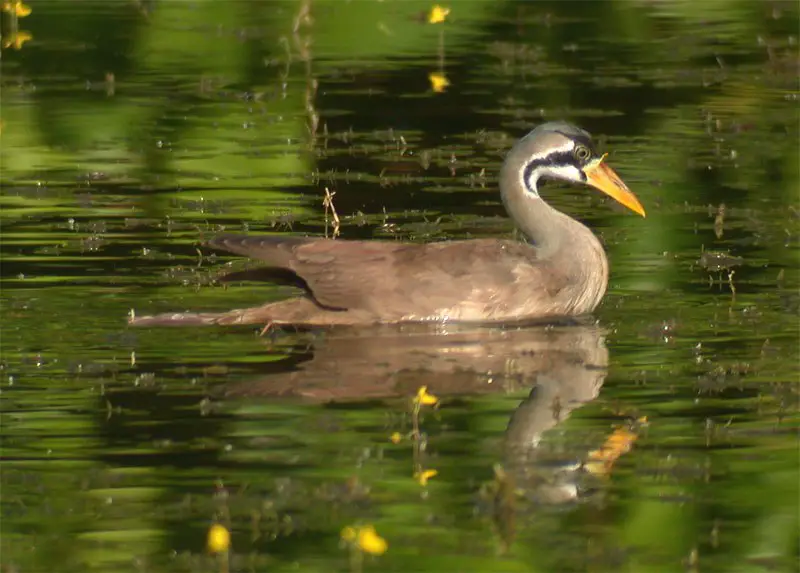
The Masked Finfoot is an endangered bird native to the fresh and brackish wetlands of Eastern India, Indochina, Malaysia and Indonesia.
It belongs to a family whose relationship with other birds remains largely unknown.
This aquatic species has distinct black-and-white plumage that covers its head like a mask while its back and wings are dark green in color.
Its striking red eyes stand out against this otherwise monotone appearance.
The masked finfoot can stay underwater for long periods due to their laterally compressed bodies which help them maneuver through water quickly and efficiently.
They feed mainly on fish but also consume frogs, crustaceans, mollusks, insects and even some plant material from time to time providing valuable ecosystem services such as controlling insect populations near riverside habitatsScientific classification:
| Kingdom | Animalia |
| Phylum | Chordata |
| Class | Aves |
| Order | Gruiformes |
| Family | Heliornithidae |
| Genus | Heliopais Sharpe, 1893 |
| Species | H. personatus |
14. Ashy-Headed Green Pigeon
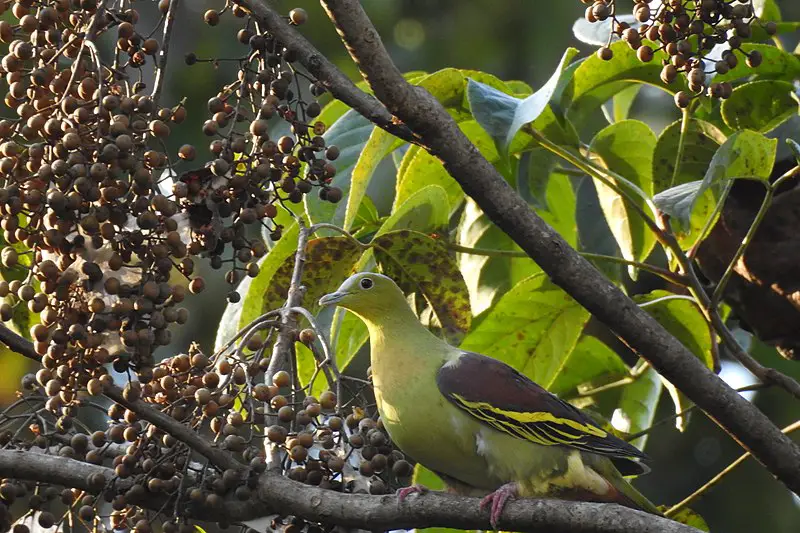
The Ashy-headed Green Pigeon is a beautiful bird found in parts of South Asia, including Nepal, northeast India Bangladesh and southwest China. It belongs to the genus Treron and has been added to IUCN’s Red List in 2014.
This species is usually seen singly or in small groups foraging on trees for fruits that form its main diet. Its head and neck are greyish brown with light green feathers covering the rest of its body giving it a unique look.
The wingspan ranges from 20–22 cm long with distinctive black tail tip which can be visible even when flying at distance making them easily recognisable amongst other birds of this region.
They live mainly on tree tops but make their nests close to ground level where they lay eggs twice during mating season every year before soaring off into the sky once againScientific classification:
| Kingdom | Animalia |
| Phylum | Chordata |
| Class | Aves |
| Order | Columbiformes |
| Family | Columbidae |
| Genus | Treron |
| Species | T. phayrei |
15. Slender-Billed Vulture
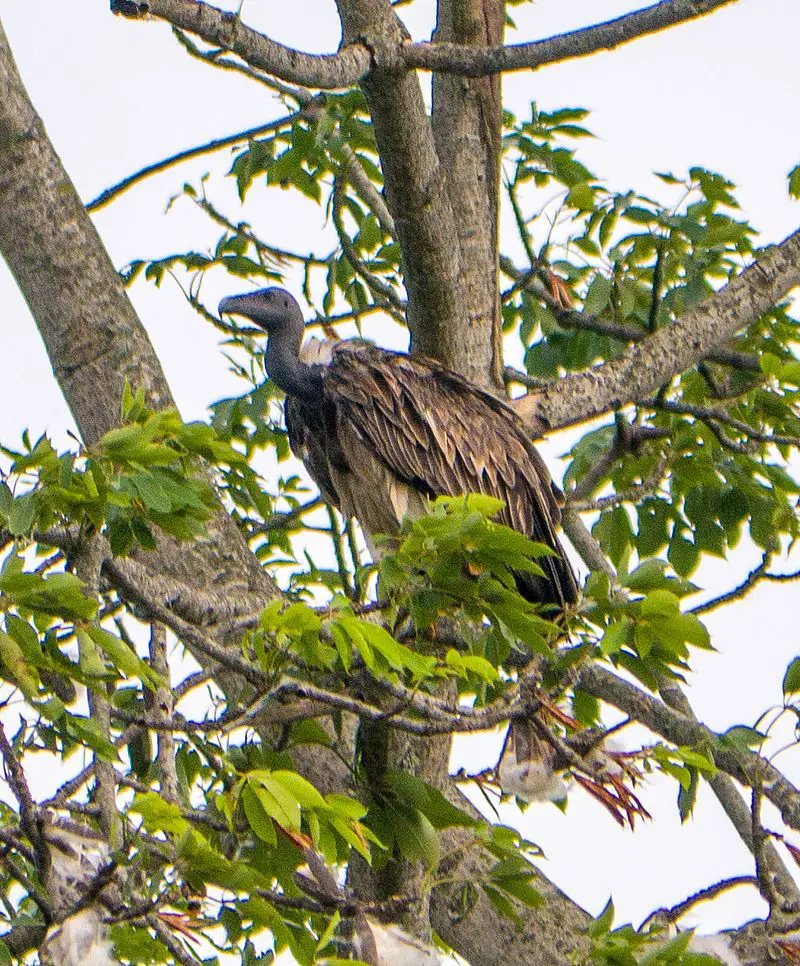
The Slender-billed Vulture is an Old World vulture species native to sub-Himalayan regions and Southeast Asia.
Unfortunately, its population has declined rapidly since 2002 due to human activities such as the use of diclofenac drugs which are toxic for them.
As of 2021, fewer than 870 mature individuals remain in this vulnerable species. It was formerly known as “long-billed vulture” or Indian vultures but now it bears its own name – slender-billed vulture.
They feed mainly on carcasses of dead animals, providing a vital ecological service by cleaning these areas from diseases and preventing further contamination from rotting corpses.
Therefore they play an important role in maintaining healthy ecosystems across their range even though their numbers have dwindled so drastically over recent yearsScientific classification:
| Kingdom | Animalia |
| Phylum | Chordata |
| Class | Aves |
| Order | Accipitriformes |
| Family | Accipitridae |
| Genus | Gyps |
| Species | G. tenuirostris |
16. Milky Stork
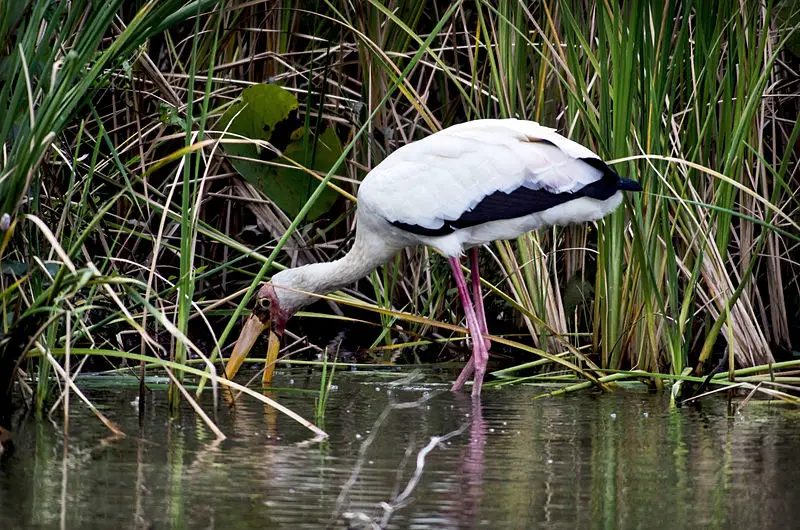
The Milky Stork is a large, white bird found in coastal mangroves of Southeast Asia. Native to Cambodia, Vietnam, Malaysia and Indonesia it has an impressive wingspan between 43-55 cm with a body length that can reach up to 97cm.
The species was once part of the Ibis genus but recently reclassified into its own Mycteria genus due to similarities with other storks like Black necked or Woolly Necked Storks.
It feeds primarily on fish by wading through shallow waters – thrusting its head underwater for prey then rising again for air as needed.
They are social birds often seen congregating together along the coasts during breeding season where they construct nests high above ground from sticks and twigs lined with mud and leaves inside tree hollows or tall grasses near water sources such as rivers or swamps.Scientific classification:
| Kingdom | Animalia |
| Phylum | Chordata |
| Class | Aves |
| Order | Ciconiiformes |
| Family | Ciconiidae |
| Genus | Mycteria |
| Species | M. cinerea |
Also Featured In: Common Birds of Indonesia,
17. Hainan Blue Flycatcher
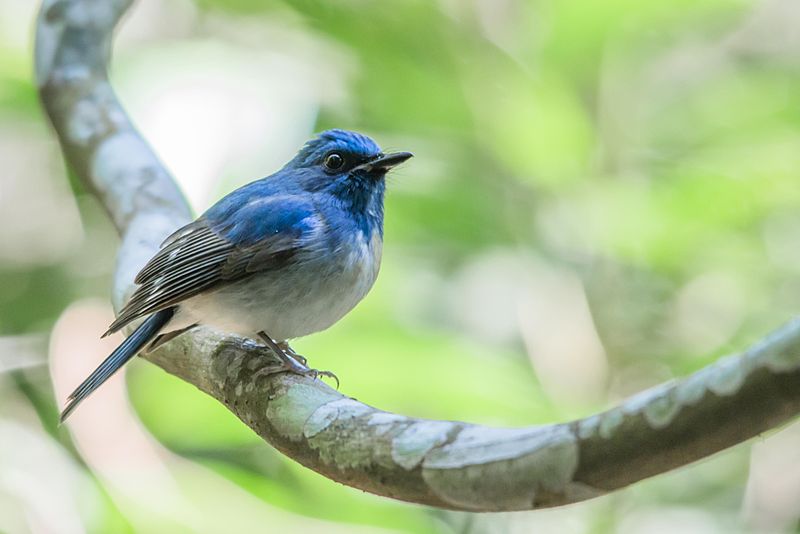
The Hainan blue flycatcher is a species of bird belonging to the family Muscicapidae. It was first described in 1900 by William Robert Ogilvie-Grant and can be found across Southeast Asia, mainly in Cambodia, China, Hong Kong, Laos Myanmar Thailand and Vietnam.
This small passerine prefers subtropical or tropical moist lowland forests as its natural habitat – making them particularly vulnerable if deforestation occurs.
The male has deep blue plumage with black wings while females are duller overall with brownish upperparts and whitish underparts; both sexes have short rounded tails that they often flick rapidly when hunting for insects amongst foliage.Scientific classification:
| Kingdom | Animalia |
| Phylum | Chordata |
| Class | Aves |
| Order | Passeriformes |
| Family | Muscicapidae |
| Genus | Cyornis |
| Species | C. hainanus |
Also Featured In: Common Birds of Hainan,
18. Siamese Fireback
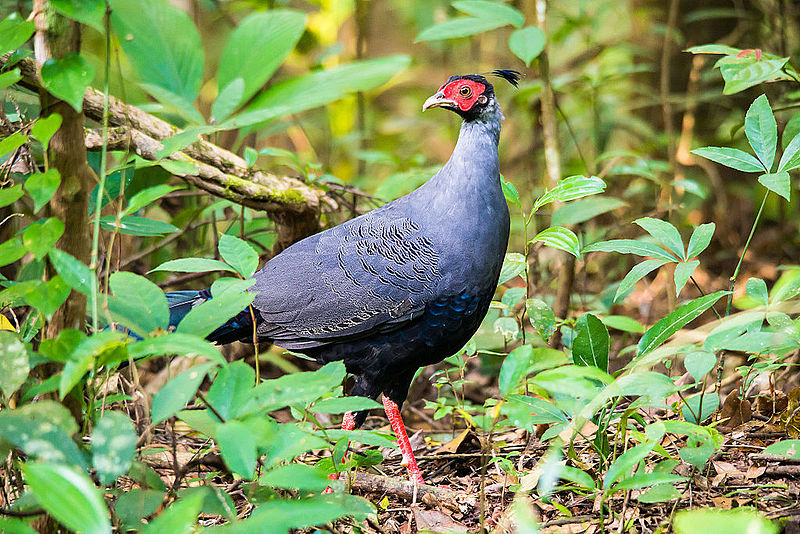
The Siamese fireback is a magnificent bird, native to Southeast Asia. It stands about 80 cm tall and has grey plumage with an extensive facial caruncle, crimson legs and feet, ornamental black crest feathers, reddish brown iris and long curved tail feathers.
The female of the species is noticeably different from the male – she sports a glossy brown body with striking blackish wings and tail feathers. This pheasant’s range stretches across Thailand, Malaysia, parts of Laos as well as western Cambodia.
They prefer lowland forests but can also be found in secondary habitats close to rivers or streams where they feed on insects like grasshoppers or other invertebrates while searching for fruits during fruiting season too.
In general these birds are shy yet curious creatures that make delightful noises throughout their habitat bringing life into any environment they inhabit.Scientific classification:
| Kingdom | Animalia |
| Phylum | Chordata |
| Class | Aves |
| Order | Galliformes |
| Family | Phasianidae |
| Genus | Lophura |
| Species | L. diardi |
19. Bar-Bellied Pitta
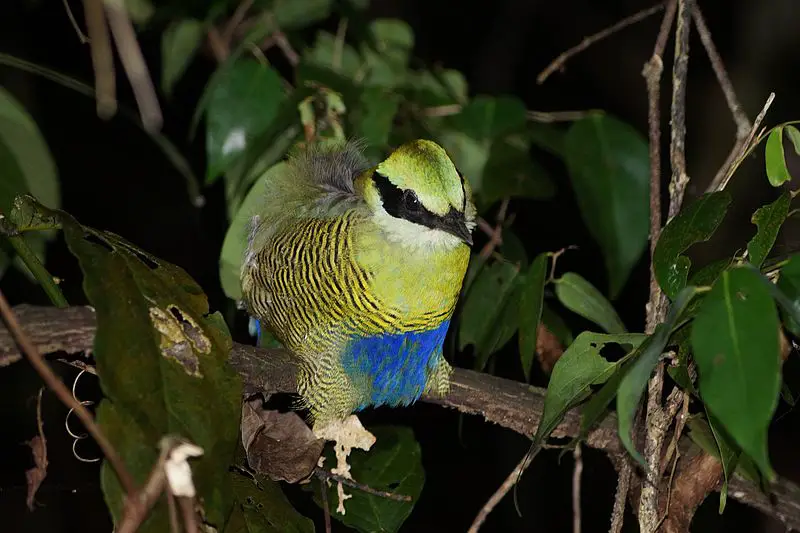
The Bar-bellied pitta is a species of bird in the Pittidae family, found in Cambodia, Laos, Thailand and Vietnam. It inhabits seasonal tropical forests and has an attractive plumage with blue upperparts and yellowish bars on its breast.
The male has a red head while females are duller overall but have bright orange underparts.
These birds feed mainly on invertebrates such as insects which they catch by hopping along the ground or gleaning from foliage. They also eat some fruit like wild figs or berries when available.
Their nests are built low to the ground within thick vegetation near streams; both parents share incubation duties for up to two weeks before chicks hatch out ready to explore their new world.Scientific classification:
| Kingdom | Animalia |
| Phylum | Chordata |
| Class | Aves |
| Order | Passeriformes |
| Family | Pittidae |
| Genus | Hydrornis |
| Species | H. elliotii |